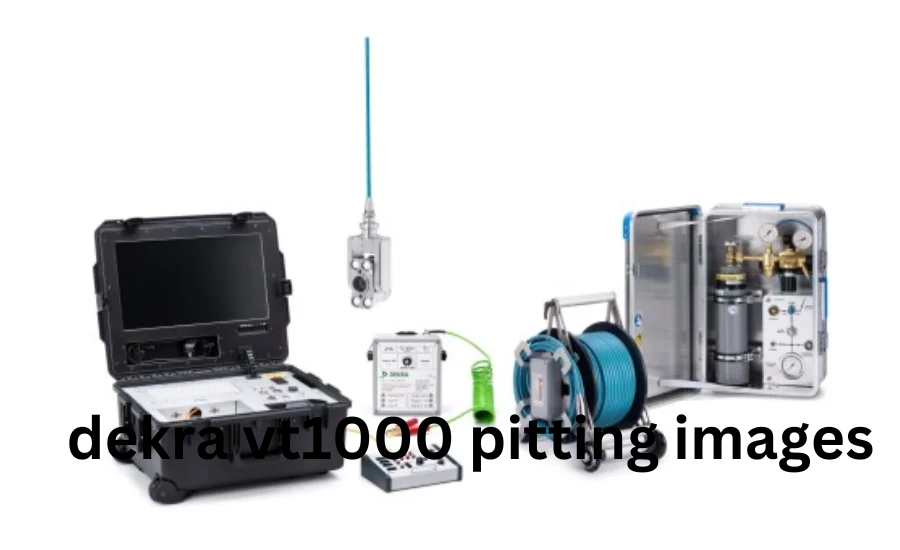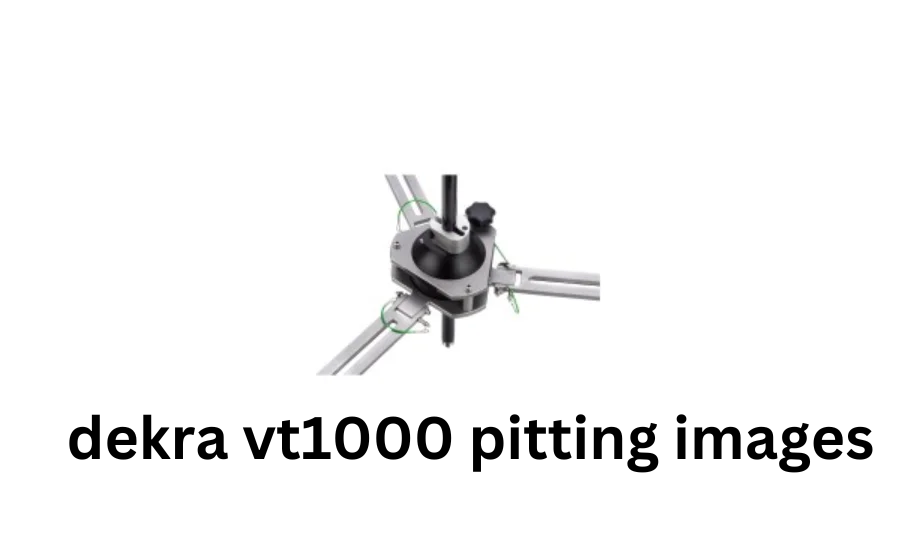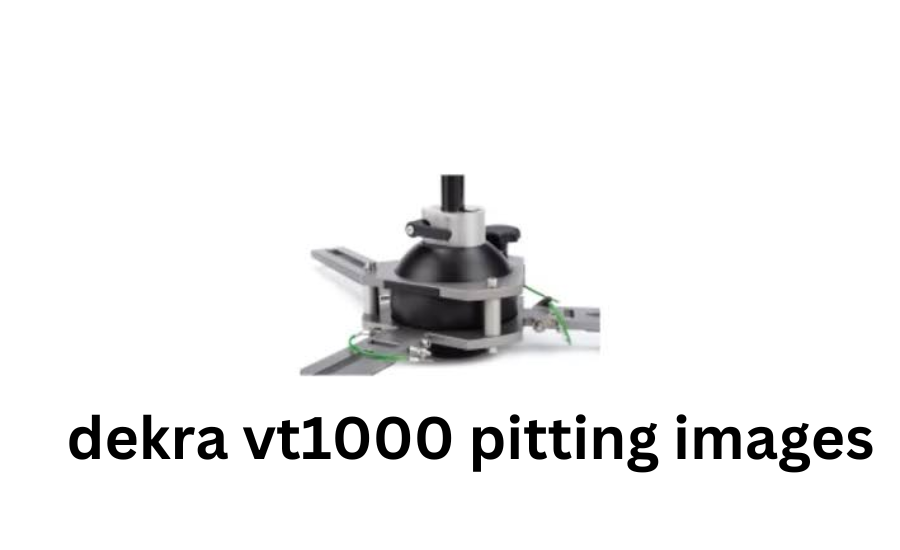If you’re curious about the DEKRA VT1000 pitting images and their significance, you’re in the right place. This post will delve into what the DEKRA VT1000 is and explore why pitting images are crucial for maintaining vehicle safety. Whether you’re involved in the automotive industry, manage a fleet, or simply have an interest in vehicle inspections, understanding this tool can offer valuable insights.
The DEKRA VT1000 is a sophisticated tool designed for vehicle inspections, providing detailed pitting images that reveal critical information about the condition of a vehicle. Pitting images are essential because they help identify wear and tear that may not be visible to the naked eye. These images are instrumental in assessing the structural integrity and safety of vehicles, allowing for early detection of potential issues that could lead to more significant problems if left unaddressed.
By the end of this post, you’ll gain a clear understanding of how the DEKRA VT1000 operates and why its pitting images are a game-changer in the realm of vehicle safety inspections. You’ll see how this tool enhances the inspection process, ensuring that vehicles are thoroughly examined and maintained to meet safety standards.
How the DEKRA VT1000 Revolutionizes Vehicle Inspections
The DEKRA VT1000 is a state-of-the-art inspection tool designed to assess the condition of vital vehicle components, including tires, brakes, and other essential parts. Developed by DEKRA, a renowned global leader in safety and testing, this technology is specifically crafted to identify signs of wear and tear. Its advanced capabilities shine in detecting early damage, particularly through its detailed pitting images.
Pitting refers to small, crater-like indentations or patterns that can appear on surfaces like brake discs or tires. These imperfections, although seemingly minor, can have a significant impact on vehicle performance and overall safety. The DEKRA VT1000’s ability to capture and analyze these pitting images allows technicians to identify and address these issues before they escalate into more serious problems.
By using the DEKRA VT1000, technicians gain a valuable tool for early detection and maintenance, which is crucial for ensuring vehicle safety and reliability. This technology enhances the inspection process by providing clear, detailed images of potential issues, ultimately helping to prevent costly repairs and ensuring that vehicles remain in optimal condition.
The Value of Pitting Images in Vehicle Inspections
Pitting images provide a crucial insight into vehicle damage that often remains invisible to the naked eye. The DEKRA VT1000 excels in capturing high-resolution images of vehicle components, such as brake discs and tires, to reveal subtle signs of wear and tear. These images are instrumental in identifying early-stage damage that could otherwise go unnoticed, helping to ensure that potential issues are addressed before they lead to serious problems.
Early detection of pitting can significantly impact vehicle safety. For instance, recognizing early signs of damage on brake discs or tires can prevent severe breakdowns, such as brake failure or tire blowouts, which could pose dangerous risks on the road. By identifying these issues early, the DEKRA VT1000 helps prevent potentially hazardous situations and enhances overall vehicle safety.
For fleet managers, drivers, and automotive technicians, pitting images are indispensable for assessing the true condition of vehicles. These detailed images offer a clearer understanding of the wear and tear that vehicles undergo, enabling more informed decisions about necessary repairs and replacements. By incorporating this technology into routine inspections, stakeholders can maintain a higher level of vehicle safety and performance.
Ultimately, the DEKRA VT1000’s ability to provide detailed pitting images transforms how vehicle inspections are conducted. It not only aids in preventing unsafe conditions but also supports better maintenance practices, contributing to the longevity and reliability of vehicles. This advanced tool ensures that all potential issues are detected and addressed promptly, keeping vehicles in optimal condition and enhancing safety on the road.
How the DEKRA VT1000 Operates

1. Scanning
The DEKRA VT1000 initiates the inspection process by scanning essential vehicle components, such as brakes and tires. This step is crucial for identifying any signs of wear or potential damage that might not be immediately visible.
2. Capturing High-Resolution Images
Once the scanning is complete, the VT1000 captures high-resolution images of the scanned components. These detailed images reveal crucial information, including pitting, cracks, and other forms of wear that could affect the vehicle’s performance and safety.
3. Advanced Image Analysis
The next phase involves the use of sophisticated software to analyze the captured images. This analysis helps in detecting and assessing any areas of concern, providing a precise evaluation of the component’s condition.
4. Generating Reports
Following the analysis, the DEKRA VT1000 produces a comprehensive report summarizing the findings. This report is designed to be user-friendly, allowing technicians and fleet managers to easily review the results and identify any necessary actions.
5. Enhancing Inspection Accuracy
By automating much of the inspection process, the DEKRA VT1000 minimizes the potential for human error. This automation ensures that inspections are conducted with high precision, leading to more reliable and consistent results.
6. Accelerating Inspection Processes
The VT1000’s advanced technology not only enhances accuracy but also speeds up the inspection process. Faster inspections mean that vehicles can be assessed and addressed more promptly, helping to maintain safety and performance on the road.
Advantages of Using the DEKRA VT1000 for Pitting Detection
Enhancing Vehicle Safety
The DEKRA VT1000 significantly boosts vehicle safety by detecting pitting early. By identifying these potential issues before they become severe, the VT1000 helps prevent dangerous failures in critical components like brakes and tires. This early detection ensures that vehicles remain safe and perform optimally, reducing the risk of accidents and breakdowns.
Cost-Efficient Repairs
One of the key benefits of the DEKRA VT1000 is its ability to save on repair costs. By catching wear and damage early, it allows for timely repairs or part replacements, which are typically less expensive than addressing major issues that could develop over time. This proactive approach helps avoid costly repairs and extends the lifespan of vehicle components.
Faster and More Efficient Inspections
The DEKRA VT1000 speeds up the inspection process significantly compared to traditional manual methods. Its advanced technology provides quick, accurate results, minimizing vehicle downtime and improving overall operational efficiency. This efficiency is crucial for fleet managers and technicians who need to keep vehicles in optimal condition without disrupting daily operations.
Ensuring Regulatory Compliance
For industries that depend on maintaining large fleets, the DEKRA VT1000 plays a crucial role in ensuring compliance with safety regulations. By providing thorough and accurate inspections, it helps businesses meet stringent safety standards and regulations, thus avoiding potential fines and enhancing operational reliability.
Understanding Pitting Images: A Simple Guide
Pitting images might seem complex at first, but they are easier to grasp once you know what to look for. These images reveal small, crater-like depressions or dents in critical vehicle components like brake discs and tires. Although these imperfections may appear minor, they can escalate into significant issues if not addressed promptly. For instance, pitting on brake discs can lead to uneven braking performance, while pitting on tires may increase the risk of a blowout.
Key Features to Note in Pitting Images

When analyzing pitting images, focus on both the size and the distribution of the pits. Larger pits or clusters of pits in specific areas are often indicators of more severe problems. Pay close attention to these details to assess the urgency of the necessary repairs. Early detection through pitting images allows for timely intervention, preventing potential safety hazards and maintaining vehicle performance.
Common Causes of Pitting
Several factors contribute to the development of pitting on vehicle components:
- Corrosion: Exposure to moisture can cause rust, leading to pitting, particularly on brake discs. This type of corrosion weakens the metal and accelerates wear.
- Heat: Frequent braking generates excessive heat, which can weaken metal surfaces and cause pitting. This is common in high-use vehicles and can affect braking efficiency.
- Debris: Small particles like rocks or dirt can become lodged in vehicle components, leading to gradual wear and pitting. Regular maintenance can help mitigate this issue.
- Aging: Over time, vehicle parts naturally experience wear and tear, resulting in pitting. This is especially noticeable in components that are heavily used.
By understanding these causes and recognizing the signs of pitting early, you can take proactive measures to address and prevent potential damage.
Proactive Maintenance to Reduce Pitting Risk
Minimizing the risk of pitting requires a proactive approach to vehicle maintenance. Regular inspections play a crucial role in identifying early signs of pitting before they escalate into serious issues. Utilizing advanced tools like the DEKRA VT1000 can significantly aid in this process by providing detailed images of vehicle components and highlighting any developing problems. By catching these early warning signs, you can address them promptly and avoid more costly repairs down the road.
Keeping Vehicle Parts Clean and Dry
Maintaining cleanliness and dryness of vehicle parts is essential in preventing pitting. Debris such as small rocks and dirt can contribute to the wear and tear of critical components, leading to pitting over time. Regular cleaning helps remove these particles, reducing the likelihood of pitting. Additionally, ensuring that components remain dry prevents moisture-related corrosion, which is a common cause of pitting on metal surfaces like brake discs.
Investing in Quality Parts
Another effective strategy to combat pitting is using high-quality vehicle parts. Superior parts are often more resistant to wear and environmental damage, extending the lifespan of components and reducing the incidence of pitting. By investing in quality replacements and upgrades, you enhance the overall durability and performance of your vehicle, which is particularly important for fleet management where reliability is key.
Protecting Against Corrosive Environments
Limiting exposure to corrosive environments can also significantly impact the longevity of your vehicle’s components. Corrosive substances, such as road salt or industrial chemicals, can accelerate the development of pitting and other forms of damage. By taking steps to protect your vehicles from these elements, such as using protective coatings or minimizing exposure, you can help preserve the integrity of critical parts and ensure your fleet remains safe and operational for an extended period.
Frequently Asked Questions (FAQs)
1. What is pitting, and why is it important to detect it?
Pitting refers to small, crater-like depressions or holes that develop on the surface of vehicle components such as brake discs and tires. Detecting pitting early is crucial because these minor imperfections can escalate into serious issues if left unchecked. Early detection helps prevent more severe damage, such as brake failure or tire blowouts, ensuring vehicle safety and reliability.
2. How can the DEKRA VT1000 help in detecting pitting?
The dekra vt1000 pitting images is an advanced inspection tool that captures high-resolution images of vehicle components. It helps identify early signs of pitting by providing detailed visuals of areas that may not be visible to the naked eye. .
3. What are some common causes of pitting?
Pitting can be caused by several factors, including corrosion from moisture exposure, excessive heat from frequent braking, debris like small rocks or dirt, and natural wear from aging components. Addressing these issues through regular maintenance can help minimize pitting and extend the lifespan of vehicle parts.
4. How can proactive maintenance help prevent pitting?
Proactive maintenance involves regular inspections and cleanings to detect and address pitting before it becomes severe. Using tools like the DEKRA VT1000 allows for early detection, while keeping vehicle parts clean and dry, investing in quality parts, and protecting against corrosive environments can further reduce the risk of pitting.
5. Why is it important to invest in high-quality vehicle parts?
Investing in high-quality vehicle parts is essential because they are generally more resistant to wear and environmental damage, which can reduce the incidence of pitting. High-quality parts contribute to the overall durability and performance of your vehicle, making them particularly valuable for fleet management and ensuring long-term reliability.
Conclusion
Proactive maintenance and early detection are key to managing pitting and ensuring vehicle safety. Tools like the dekra vt1000 pitting images offer valuable insights by capturing detailed images of critical components, enabling timely interventions before minor issues become major problems. By keeping vehicle parts clean and dry, investing in high-quality replacements, and protecting against corrosive environments, you can significantly reduce the risk of pitting. Implementing these strategies not only enhances the durability and performance of your vehicles but also ensures a safer, more reliable driving experience.
Stay in touch for more updates and alerts: Vents Tribune!

